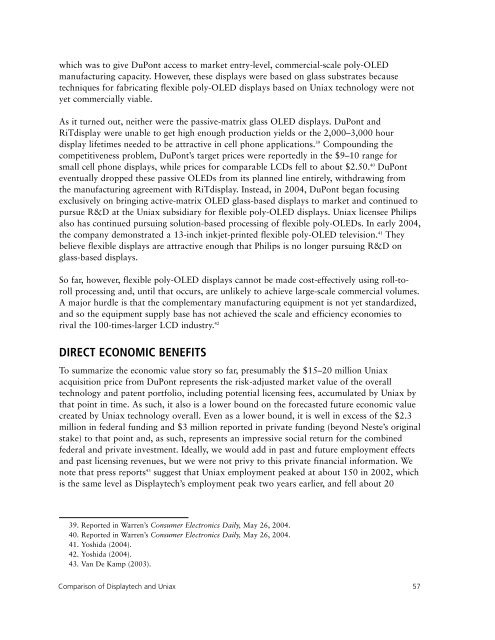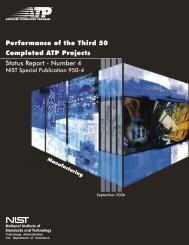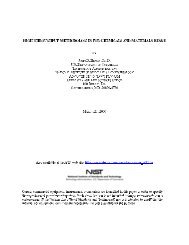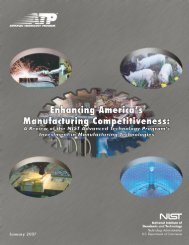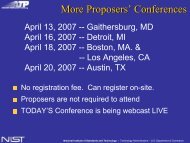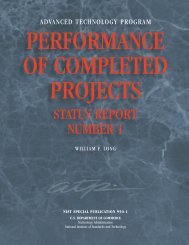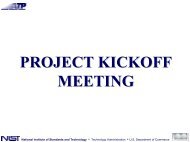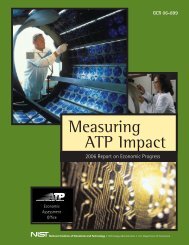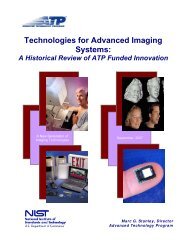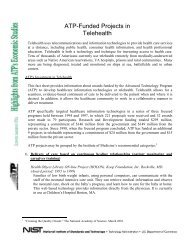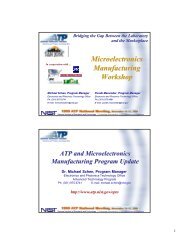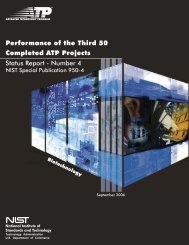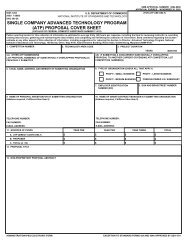Philips successfully demonstrated in 2000. 36 Indeed, these so-called organic thin filmtransistors (OTFT) might enable flexible integrated circuits that could be combined withflexible OLED displays for future radical new product categories, both the OLED <strong>and</strong> OTFTstemming in part from Heeger’s <strong>and</strong> Uniax’s pioneering work.Uniax survived with cash flow from these processing technology licenses, combined withlater limited industry contracts, related sales <strong>of</strong> pilot demonstration prototypes, <strong>and</strong>,significantly, government contracts. Before the <strong>ATP</strong> award, Displaytech also had the lattertwo sources <strong>of</strong> cash flow, but no licensing revenues. Like Displaytech, Uniax was wellplugged into <strong>and</strong> got substantial cash flow sustenance from other non-<strong>ATP</strong> federal fundingsources. In the years following Uniax’s 1993 <strong>ATP</strong> proposal application, they did manage towin a series <strong>of</strong> federal contracts, mainly through SBIR awards from the Office <strong>of</strong> NavalResearch (ONR) <strong>and</strong> the Air Force, <strong>and</strong> related to DARPA <strong>and</strong> the Ballistic Missile DefenseOffice. Between 1994 <strong>and</strong> early 1999, these totaled at least $2.3 million across at least ninedifferent awards. 37Another large equity infusion came in February 1996 when Philips <strong>and</strong> Hoechst eachinvested $1.5 million for minority equity stakes in Uniax. This investment enabled Uniaxto install a $2 million clean room <strong>and</strong> pilot production line. Uniax believes this fundingsignificantly accelerated their development <strong>of</strong> “medium information content emissivedisplays,” which they successfully demonstrated in 1997. Uniax succeeded in producingthe world’s first poly-OLED flexible plastic displays. Again, such a demonstration <strong>and</strong> stepstoward commercialization were the basis for the <strong>ATP</strong> proposal application. Uniax managedto proceed using private equity funding instead. Thereafter, with a proven demonstration inh<strong>and</strong> <strong>and</strong> the availability <strong>of</strong> a pilot production capability, Uniax was able to win at leastsix large government contracts between late 1996 <strong>and</strong> 1999, with a combined value <strong>of</strong>$2 million.Finally, in March 2000, DuPont agreed to acquire Uniax <strong>and</strong> its patent portfolio. Uniaxbecame <strong>and</strong> continues as a division <strong>of</strong> DuPont Displays. While terms <strong>of</strong> the acquisition werenot publicly disclosed, detailed perusal <strong>of</strong> DuPont’s 10K <strong>and</strong> 10Q SEC filings after theacquisition place the value in the neighborhood <strong>of</strong> $15–20 million. DuPont added Uniax’spoly-OLED <strong>and</strong> melt- <strong>and</strong> solution-processing technologies to its portfolio <strong>of</strong> new displaytechnologies. It shortly thereafter invested an additional $15 million in a poly-OLEDmarketing group associated with Uniax, while at the same time hedging its technological betswith $27.6 million for an 8 percent stake in Ritek (<strong>and</strong> its display subsidiary RiTdisplay) inTaiwan. 38 Under the agreement, Ritek built an automated poly-OLED production line, with amonthly capacity <strong>of</strong> 35,000 small (sub-4-inch) passive-matrix displays. RiTdisplay alsohedged its bets <strong>and</strong>, in parallel, continued to produce small-molecule OLED displays underlicense from Kodak. DuPont agreed to outsource 80 percent <strong>of</strong> its orders to RiTdisplay,36. Pesala et al. (2001).37. Commerce Business Daily, several editions: October 17, 1994; August 24, 1995; March 28, 1996; August21, 1996; December 2, 1996; July 9, 1998; September 17, 1998; September 14, 1999; October 4, 1999.38. Contractual details reported in Consumer Electronics, May 21, 2001.56 DIRECT AND SPILLOVER EFFECTS OF <strong>ATP</strong>-FUNDED PHOTONICS TECHNOLOGIES
which was to give DuPont access to market entry-level, commercial-scale poly-OLEDmanufacturing capacity. However, these displays were based on glass substrates becausetechniques for fabricating flexible poly-OLED displays based on Uniax technology were notyet commercially viable.As it turned out, neither were the passive-matrix glass OLED displays. DuPont <strong>and</strong>RiTdisplay were unable to get high enough production yields or the 2,000–3,000 hourdisplay lifetimes needed to be attractive in cell phone applications. 39 Compounding thecompetitiveness problem, DuPont’s target prices were reportedly in the $9–10 range forsmall cell phone displays, while prices for comparable LCDs fell to about $2.50. 40 DuPonteventually dropped these passive OLEDs from its planned line entirely, withdrawing fromthe manufacturing agreement with RiTdisplay. Instead, in 2004, DuPont began focusingexclusively on bringing active-matrix OLED glass-based displays to market <strong>and</strong> continued topursue R&D at the Uniax subsidiary for flexible poly-OLED displays. Uniax licensee Philipsalso has continued pursuing solution-based processing <strong>of</strong> flexible poly-OLEDs. In early 2004,the company demonstrated a 13-inch inkjet-printed flexible poly-OLED television. 41 Theybelieve flexible displays are attractive enough that Philips is no longer pursuing R&D onglass-based displays.So far, however, flexible poly-OLED displays cannot be made cost-effectively using roll-torollprocessing <strong>and</strong>, until that occurs, are unlikely to achieve large-scale commercial volumes.A major hurdle is that the complementary manufacturing equipment is not yet st<strong>and</strong>ardized,<strong>and</strong> so the equipment supply base has not achieved the scale <strong>and</strong> efficiency economies torival the 100-times-larger LCD industry. 42DIRECT ECONOMIC BENEFITSTo summarize the economic value story so far, presumably the $15–20 million Uniaxacquisition price from DuPont represents the risk-adjusted market value <strong>of</strong> the overalltechnology <strong>and</strong> patent portfolio, including potential licensing fees, accumulated by Uniax bythat point in time. As such, it also is a lower bound on the forecasted future economic valuecreated by Uniax technology overall. Even as a lower bound, it is well in excess <strong>of</strong> the $2.3million in federal funding <strong>and</strong> $3 million reported in private funding (beyond Neste’s originalstake) to that point <strong>and</strong>, as such, represents an impressive social return for the combinedfederal <strong>and</strong> private investment. Ideally, we would add in past <strong>and</strong> future employment effects<strong>and</strong> past licensing revenues, but we were not privy to this private financial information. Wenote that press reports 43 suggest that Uniax employment peaked at about 150 in 2002, whichis the same level as Displaytech’s employment peak two years earlier, <strong>and</strong> fell about 2039. Reported in Warren’s Consumer Electronics Daily, May 26, 2004.40. Reported in Warren’s Consumer Electronics Daily, May 26, 2004.41. Yoshida (2004).42. Yoshida (2004).43. Van De Kamp (2003).Comparison <strong>of</strong> Displaytech <strong>and</strong> Uniax 57


